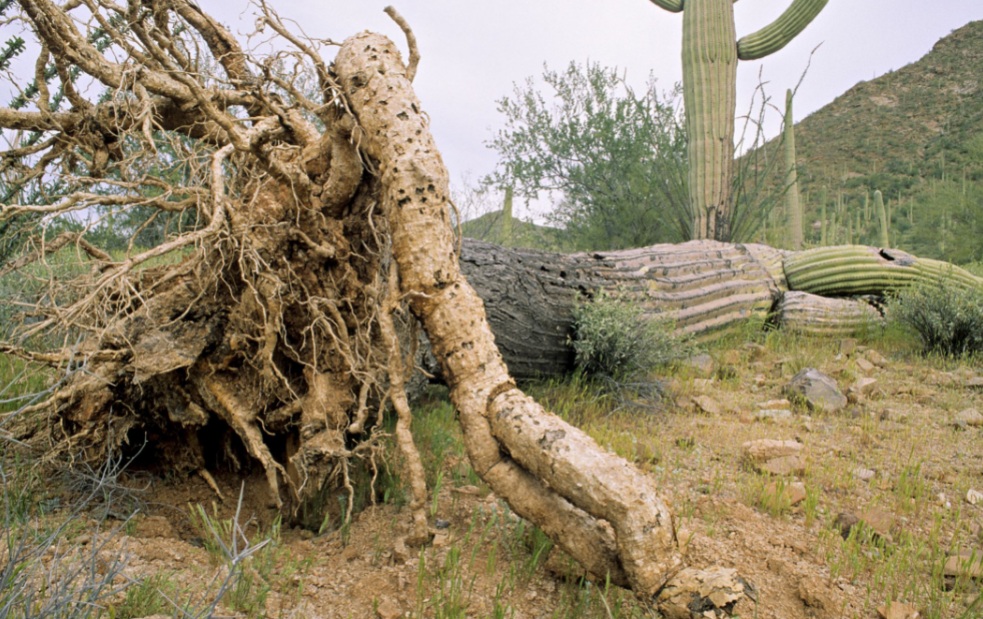What Do Cactus Roots Look Like? Unearthing The Mysteries
What do cactus roots look like? Have you ever wondered what goes on underground under this prickly cactus in your garden? You may be surprised to discover that most cacti don’t have roots that mirror the shapes of their stems and leaves above ground.
While cactus spines and pads have evolved to conserve water in hot and dry environments, they have developed roots very differently. Beneath the soil’s surface is an intricate web of roots specially adapted to absorb and store as much moisture as possible when it’s available.
Next time you’re gardening, dig down around your cactus and unearth the mysteries of what its roots look like – you’ll uncover a secret world you never knew existed.

Introduction: the hidden half of cacti
What goes on beneath the soil with cacti roots is a mystery to most. Their roots are tucked away, doing the important work of absorbing water and anchoring these spiny succulents in place. Let’s dig a little deeper and unearth the secrets of cacti’ roots.
Cactus root systems are typically shallow but spread wide, maximizing the surface area to soak up any available moisture. Some, like saguaro roots, only extend a couple of feet down but can stretch out over 50 feet from the plant.
Prickly pear cactus roots differ and also grow over a substantial distance. The broad, shallow root system of cacti makes them prone to toppling over, so many smaller species eventually develop woody trunks for support.
While cacti roots seek out moisture, they are well-adapted to dry, arid conditions. Waxy, waterproof tissue helps roots retain any water they absorb. Cacti also have an extensive network of fine root hairs, increasing their ability to take in and hold onto this precious resource.

Some species only sprout root hairs after significant rain, allowing them to quickly utilize the temporary abundance of water before it evaporates again.
Shallow spread: fibrous roots near the surface
Cacti are known for their spiny stems and shallow root systems. Unlike most plants, cacti’ roots tend to spread out just below the soil surface, absorbing any available moisture after infrequent rains.
Cactus roots are fibrous, meaning they consist of many thin roots rather than a single taproot. These fibrous roots form a dense mat just below the top few inches of soil, allowing the cactus plant to quickly absorb any water. The roots also have special cells for storing water and nutrients.
Some cactus roots can spread 15-20 feet from the base of the plant, though most are within 3 to 6 feet of the primary root of the stem.
The roots grow outward and down, staying within the top foot of the soil. Some species, like prickly pears, have roots that spread farther in search of moisture.
The shallow roots are efficient at absorption but also make cacti more prone to toppling over. Their root hairs can’t firmly anchor the plant since they don’t extend very deep. To compensate, many cacti develop a broad, sturdy base and lower center of gravity than other roots. Some cactus roots grow in clusters, with the stems providing support for one another.
While the roots of a succulent plant may not run deep, they have fine and hair roots that are well adapted to the harsh, arid environments cacti call home. Their shallow, fibrous roots allow them to swiftly gather precious resources and store them for the long, dry periods between rains.

Seeking sustenance: taproots drilling down deep
Cacti are well adapted to arid environments, but their deep roots will still need to find water and nutrients to sustain the plant. Unlike most plants with shallow fibrous roots, cacti typically have deep taproots that extend deep into the ground.
The majority of cacti’s roots are made up of a long central taproot that grows straight down. These taproots can extend 10 to 15 feet deep roots in mature cacti, allowing them to tap into underground water sources and absorb any available moisture. The taproot also absorbs nutrients from deep within the soil.
Once the taproot has anchored the cactus and reached moisture, new lateral roots also may start to grow outward from it, spreading out near the surface. These shallow fibrous roots absorb additional water and nutrients when available and also help stabilize the cactus. In some species, these new lateral roots tend to spread out 50 to 100 feet from the primary roots.

The roots of succulent plant are generally shallow and sparse compared to the primary roots of most plants. They only grow as much as is necessary to absorb just enough water to sustain the cactus. Excess roots would require more energy and water to maintain, so cacti have evolved to be highly efficient.

The roots themselves are often corrugated or ribbed, which increases their surface area for better water absorption when the opportunity arises. Most types of succulent plants also have a waxy coating that helps prevent moisture loss in dry, hot soil.
Some species have roots that turn green when exposed to light, allowing them to photosynthesize and produce food for the cactus.
While cactus roots extend significant depths, the majority types of cactus roots remain relatively shallow. The taproot and lateral roots work together to fully exploit any available moisture and nutrients in their harsh environments. For many cacti species, the roots are the key to surviving and thriving in deserts and arid lands.

Getting a grip: adventitious roots to secure
Cacti are well known for their spiny stems, but what is beneath the soil? Their root systems are equally fascinating, allowing these desert dwellers to thrive where other plants perish.
Cacti produce tuberous roots, which grow from parts of the plant other than the main root system. These roots emerge from the lower stems and spread out to grip the surrounding soil. The roots are shallow but dense, radiating out from the base of the cactus. They efficiently absorb any available moisture and also anchor the cactus firmly in place.

Some cacti, like prickly pears, have roots that can spread over a large area, up to 10-15 feet in diameter for a mature plant. The roots of barrel cacti are more compact but also shallow and widespread.
These broad, lateral root systems allow the plants to collect rainwater over a large surface area before it evaporates from the desert soil.
The tuberous roots are often thick and corky, able to withstand prolonged drought. Some cacti have roots that shrink back into the soil during dry periods, minimizing water loss. When rain does fall, the roots quickly absorb as much moisture as possible, expanding up to 40% of their dry size. These adaptations are crucial for survival where water is scarce.
While succulent roots remain largely unseen, they are fascinating examples of natural engineering. Their morphology and physiology allow them to thrive in environments too harsh for most other plants.
Next time you see a cactus, picture the dense network of roots below the soil that make its existence possible in such an unforgiving climate. The humble cactus root system is a marvel of evolution and a key part of what makes these desert plants seem so resilient.

Strange shapes and sizes: the diversity of cactus roots
Cactus roots come in all shapes, sizes, and forms. Unlike typical plant roots that grow down and outward, cactus roots are often shallow and spread out horizontally. Some cacti have roots that barely extend beyond the base of the plant, while others have roots that stretch out many feet. The diversity of cactus roots allows them to thrive in harsh, arid environments.

Some cacti, like prickly pears, have roots that look like thick, woody carrots. These taproots grow straight down and can extend deep into the soil to reach groundwater.
Other cacti, such as saguaro and organ pipe cactus, have shallow, fibrous root systems that mostly spread out sideways at the surface.
These wide-ranging types of roots efficiently absorb any available surface moisture after rare rains. Certain cacti in the Opuntia family have roots that look like tangled masses of string, while the roots of barrel cacti resemble a tangled bird’s nest.

The shape and depth of a cactus root system depend largely on its habitat and how it obtains moisture. Cacti in dry, sandy deserts often have long, spreading roots to maximize the area they can draw water from. Cacti growing in rocky terrain usually have shallow, web-like roots that cling to cracks and crevices. Some jungle cacti, like orchid cacti, have aerial roots that never even touch the ground!
While cactus root system may not look like typical roots, they are superbly adapted to the harsh conditions in which cacti grow. Their strange shapes and sizes, whether taproots, fibrous roots, or stringy masses, allow them to efficiently find and absorb the little moisture available in their environment. The cactus root system is as bizarrely diverse as the plants they anchor and nourish.

Conclusion
So there you have it – the mysterious truth about the cactus root system finally revealed. As you’ve learned, they’re not just shallow little nubs designed to absorb the odd raindrop. Cacti roots are complex, extensive systems that anchor these spiny succulents in place and allow them to thrive in harsh, arid environments.
Even though most of the action happens underground, cacti roots play a vital role in how these plants survive and adapt. The next time you see a cactus, whether in the wild or someone’s yard, think about everything happening beneath the surface that you can’t see. There’s a whole secret world of roots down there, working hard to keep that cactus alive against all odds.

FAQ
Are cactus roots shallow or deep?
Cacti roots are generally shallow.
What does the root of a cactus look like?
Cacti can be rooted with large aerial roots that appear as strands of air. Some cacti have fleshy, thick tuberous roots that serve as food and water storage organs. This root system is usually an extended system that spread laterally away from plants. These types of roots are shallow in desert environments.
Aerial roots grow from some species of cacti, but not all. You will only see aerial roots on species that have stems, such as the Christmas cactus, and climbing species like the orchid cactus and night-blooming cereus.
What do healthy cactus roots look like?
Healthy succulents usually look white or light-colored and long enough to hold your soil together during dry spells. Pruning cactus roots will stimulate new root sprouts and strengthen the cactus root systems. Healthy root also looks damp but the deeper the tuberous roots it grows, the thinner it will become.
What kind of roots do cactus have?
The root of the cactus is covered with a cork-shaped layer to prevent water leakage. Some cacti have tuberous roots that are thick and fleshy and are used to store nutrients and water. The majority of plants have vascular root structures which spread and form connective tissues.

Greetings, dear succulent lovers! I’m Jennifer West and I’m happy to share with you practical tips and guides on growing and caring for succulents, as well as all the magical facts about these unique plants. Grateful to have you on this green journey with me! Check out more about our team here.







